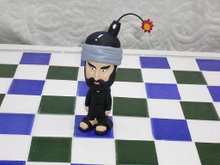
Battle Bots: Iraq, Afghanistan Unprecedented In Widespread Use of Warbots
—Ace
And more are coming, including centipede-like crawlers that weave their way through minefields detonating one mine per leg.
The wars in Afghanistan and Iraq have become an unprecedented field study in human relationships with intelligent machines. These conflicts are the first in history to see widespread deployment of thousands of battle bots. Flying bots range in size from Learjets to eagles. Some ground bots are like small tanks. Others are the size of two-pound dumbbells, designed to be thrown through a window to scope out the inside of a room. Bots search caves for bad guys, clear roads of improvised explosive devices, scoot under cars to look for bombs, spy on the enemy and, sometimes, kill humans.Even more startling than these machines' capabilities, however, are the effects they have on their friendly keepers who, for example, award their bots "battlefield promotions" and "purple hearts." "Ours was called Sgt. Talon," says Sgt. Michael Maxson of the 737th Ordnance Company (EOD). "We always wanted him as our main robot. Every time he was working, nothing bad ever happened. He always got the job done. He took a couple of detonations in front of his face and didn't stop working. One time, he actually did break down in a mission, and we sent another robot in and it got blown to pieces. It's like he shut down because he knew something bad would happen." The troops promoted the robot to staff sergeant -- a high honor, since that usually means a squad leader. They also awarded it three "purple hearts."
...
Ted Bogosh recalls one day in Camp Victory, near Baghdad, when he was a Marine master sergeant running the robot repair shop.
That day, an explosive ordnance disposal technician walked through his door. The EODs, as they are known, are the people who -- with their robots -- are charged with disabling Iraq's most virulent scourge, the roadside improvised explosive device. In this fellow's hands was a small box. It contained the remains of his robot. He had named it Scooby-Doo.
Staff Sgt. James Craven (background) and Sgt. Domonic Amaral run tests on two Talon 3Bs at a base in Tikrit, Iraq. The Talon 3B is one of several robots used by explosive ordnance disposal units in search of improvised explosive devices.
"There wasn't a whole lot left of Scooby," Bogosh says. The biggest piece was its 3-by-3-by-4-inch head, containing its video camera. On the side had been painted "its battle list, its track record. This had been a really great robot."
The veteran explosives technician looming over Bogosh was visibly upset. He insisted he did not want a new robot. He wanted Scooby-Doo back.
"Sometimes they get a little emotional over it," Bogosh says. "Like having a pet dog. It attacks the IEDs, comes back, and attacks again. It becomes part of the team, gets a name. They get upset when anything happens to one of the team. They identify with the little robot quickly. They count on it a lot in a mission."
The bots even show elements of "personality," Bogosh says. "Every robot has its own little quirks. You sort of get used to them. Sometimes you get a robot that comes in and it does a little dance, or a karate chop, instead of doing what it's supposed to do." The operators "talk about them a lot, about the robot doing its mission and getting everything accomplished." He remembers the time "one of the robots happened to get its tracks destroyed while doing a mission." The operators "duct-taped them back on, finished the mission and then brought the robot back" to a hero's welcome.
Near the Tigris River, operators even have been known to take their bot fishing. They put a fishing rod in its claw and retire back to the shade, leaving the robot in the sun.
Of the fish, Bogosh says, "Not sure if we ever caught one or not."
Thanks to Michelle.





No comments:
Post a Comment